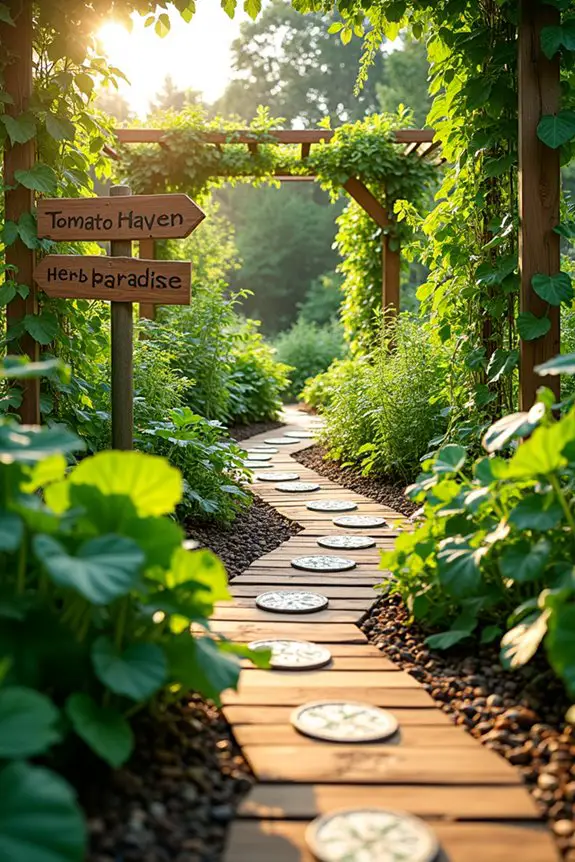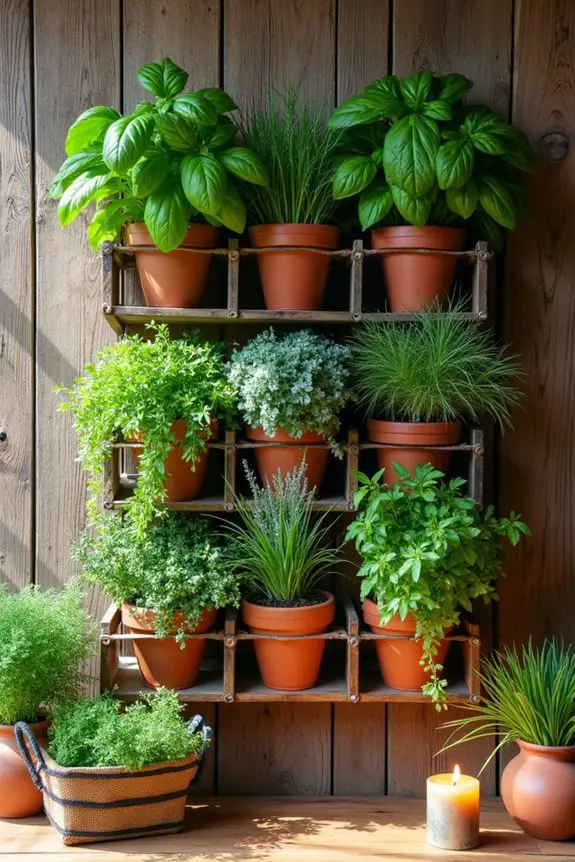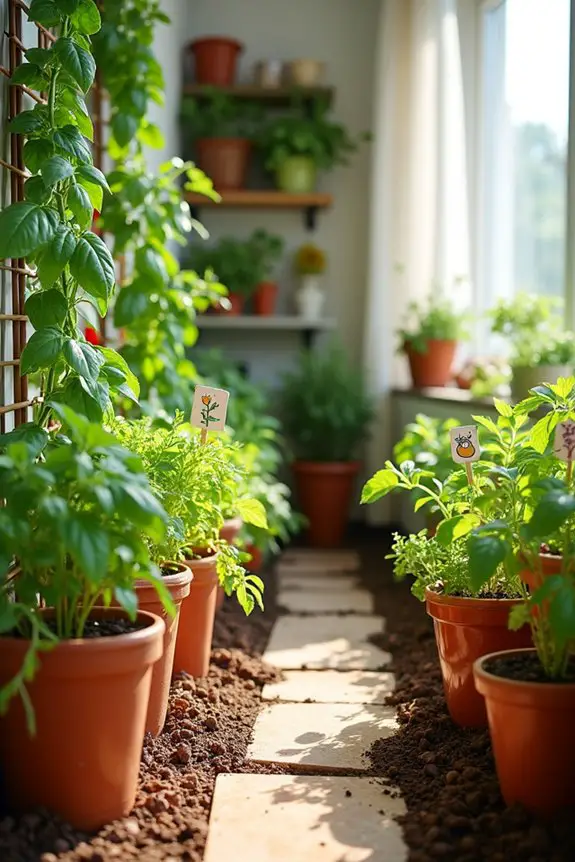You might think your veggie garden is too small or basic for a makeover, but trust me, it’s easier than it sounds. With a few creative tweaks—like colorful trellises and DIY raised beds—you can transform it into a thriving, eye-catching space. Who wouldn’t want a garden that’s not only productive but also a joy to look at? Let’s explore some fresh designs that’ll have you itching to dig in, shall we?
Vertical Veggie Garden Layouts
If you’re short on space but big on veggie dreams, vertical gardens are your secret weapon.
Imagine colorful trellises reaching for the sky, creative containers stacked just right, and geometric patterns that make your garden pop.
It’s like an art project you can eat—so let’s get those DIY raised beds and biodiversity ideas rolling, shall we?
1. Creative Container Arrangements
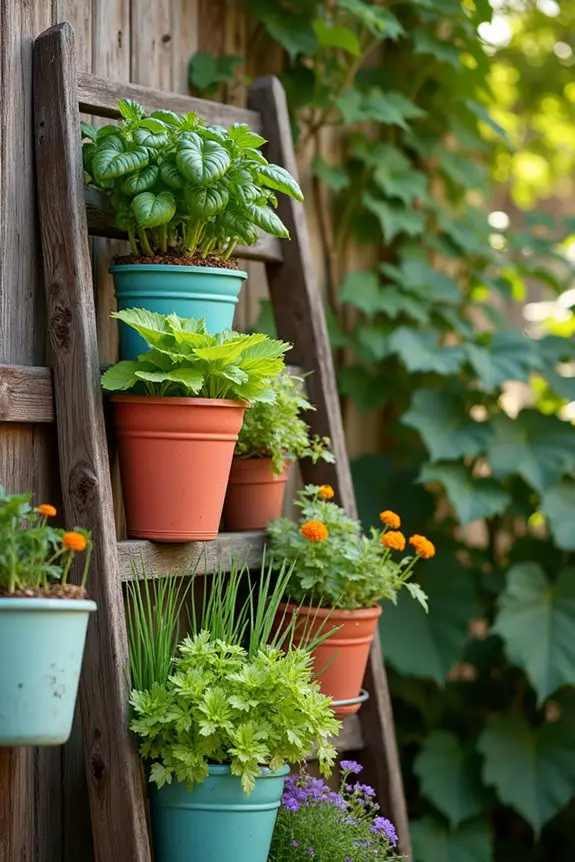
When it comes to veggie gardens, creativity is key, especially if space is tight. Enter the world of vertical container arrangements. These clever designs not only maximize your growing potential but also add a unique flair to your outdoor or balcony space. Imagine a cascade of colorful vegetables climbing upwards, creating a vibrant tapestry that’s as beautiful as it’s functional.
So, how do you get started with this horizontal-turned-vertical gardening trend? It’s a breeze, really. First off, choose sturdy containers. Think stacked wooden pallets, hanging planters, or even repurposed old ladders. I once used an old shoe rack—yes, you read that right. It turned into a quirky yet charming vertical garden that had my neighbors asking if I was running a secret salad bar.
Plus, I got to show off my prized cherry tomatoes on the top shelf, like they were the crown jewels of my garden.
Next, pick your greens wisely. Leafy veggies like lettuce, spinach, and herbs thrive in smaller spaces and create a lush display. Arrange them to optimize sunlight; the taller plants should sit at the top while the shorter ones bask in the soil below.
Watering is a must, but don’t go overboard. Trust me, swimming tomatoes aren’t a good look, and you don’t want to drown those poor plants. A quick mist or a gentle soak at the roots will keep them happy.
Lastly, be prepared to enjoy—or should I say, savor—your hard work. There’s nothing like plucking fresh basil for your evening pasta or grabbing a handful of greens for a delicious salad. Additionally, starting your own seeds in a seed starter greenhouse can give you a head start on your vertical gardening journey.
With vertical container arrangements, you’re not just growing veggies; you’re creating a delightful showcase of nature’s bounty that reflects your style and personality. So why not go ahead and take your veggie garden to new heights?
2. Geometric Pattern Planting
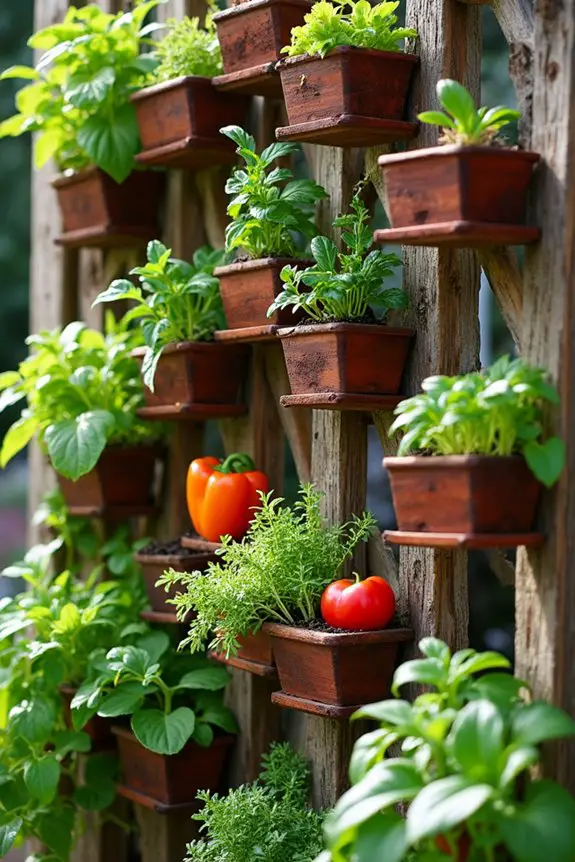
Geometric pattern planting in a vertical veggie garden isn’t just for looks—it’s a genius way to maximize space and keep things aesthetically pleasing. By arranging plants in bold shapes, like chevrons, circles, or classic grid patterns, you can create a visually exciting garden that draws the eye and sparks the imagination. Plus, let’s be honest—a little geometry in your garden is like giving it a little personality. Who wouldn’t want to show off their quirky veggie masterpiece?
To get started, grab some pots or containers and sketch out your garden layout. Think of it like a puzzle, where each plant is a piece that fits just right. You might start with tall plants, like pole beans, and then fill in the gaps with medium-height veggies like peppers, before finishing off with herbs or smaller greens at the base. Using a seed germination heat mat can even help simulate the ideal conditions for your seeds, giving them a better start.
Trust me, envisioning your garden this way is half the fun—just like putting together a jigsaw puzzle, but with delicious rewards. As you plant, keep your patterns organized but feel free to embrace a bit of chaos. Maybe place a random scarlet runner bean alongside its more understated cousins for a pop of surprise.
Don’t be afraid to mix colors, too. Just picture deep purple eggplants nestled next to bright green basil—it’s a feast for the eyes as much as it’s for the palate. Remember, though: water is key. Just because you’re channeling geometry doesn’t mean you can forget about those thirsty plants crying out for a drink. Consider incorporating self-watering hanging planters to help maintain moisture levels and make your gardening experience even easier.
Lastly, take a moment to step back and admire your layout. There’s something empowering about looking at your geometric creation and thinking, “I did that.”
And when it comes time to harvest, you’ll feel like a veggie Picasso, proudly presenting your glorious produce. Sure, my last geometry test wasn’t pretty, but this garden layout? It’s definitely got an A+ vibe. So why not give it a try? Your dinner plates—and your garden spirits—will thank you.
3. Colorful Trellis Incorporations
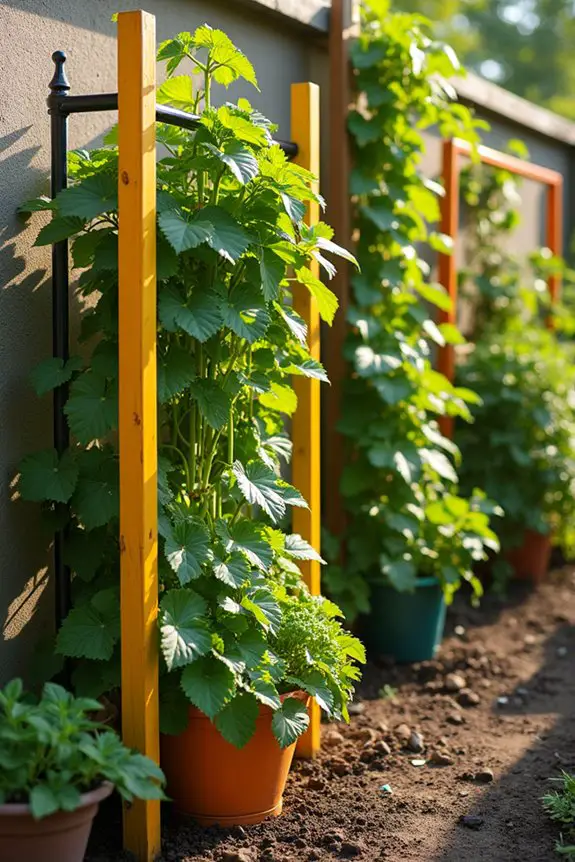
When it comes to designing a vertical veggie garden, incorporating colorful trellises can totally elevate the whole vibe. Not only do they provide essential support for climbing plants, but they also add a splash of personality and visual interest to your garden. Why let your garden be a boring patch of greens when it can be a vibrant showcase? Picture a bright yellow trellis holding up your twinkling peas, or a sleek, black frame supporting velvety purple beans. It’s like giving your plants a stylish boutique to live in.
To start, think about the colors that make you smile. You could go bold with primary colors or stick to softer pastels for a more relaxed feel. Once you’ve picked your palette, consider the materials. Wooden trellises can be painted, while metal ones often come with some interesting finishes. I once spray-painted an old trellis a cheerful orange, and it instantly made my sad zucchini feel like they were on a tropical vacation. Additionally, adding a hydroponic seed starter kit can provide you with healthy seedlings that thrive and climb in your vibrant garden.
Next, think about the plants you’ll be climbing up these beauties. Things like peas, cucumbers, and pole beans work great. As they grow, their vines interweave with the trellis, almost like nature’s art installation. Just imagine beckoning friends over to your garden and showing off the colorful structures and lush greenery—it’s like being the proud parent of a really cool art project.
Don’t forget about positioning, either. Place your trellis where they’ll get ample sunlight, perhaps against a sunny wall or in a corner that needs some pizzazz. As you plant, check climbing habits—some plants might need a little more nudging to find their way up, while others are just enthusiastic, racing upwards without any help.
If you’re like me and have a tendency to forget about watering, make sure your trellisies are in a spot where they’re easy to reach. No one wants to play hide and seek with thirsty plants. Additionally, a well-designed wisteria trellis can really transform your garden into a stunning focal point.
4. DIY Raised Bed Configurations
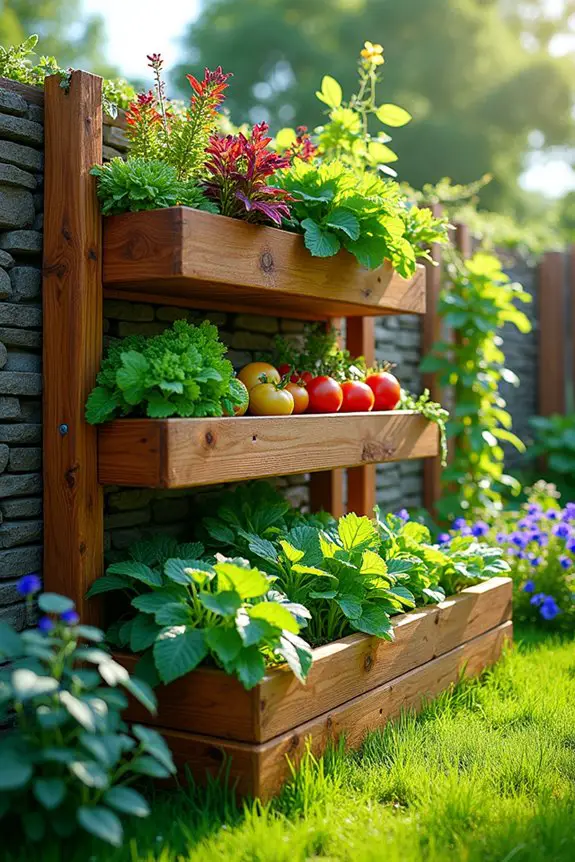
When you think of veggie gardens, do you ever picture a basic plot of dirt? Boring, right? Let’s elevate that vision. Enter DIY raised bed configurations, the unsung heroes of vertical gardening! Not only do they maximize space and improve drainage, but they also bring a polished look to your backyard. Picture a neat row of raised beds, each one beckoning with the promise of thriving veggies—it’s like an edible masterpiece waiting to happen.
First, let’s talk shapes and sizes. You can choose classic rectangles or get quirky with some L-shapes or circles. Just remember, in the garden, you can embrace your wild side! A multi-tiered design not only saves space but also adds depth to your garden. Think of it as building a three-dimensional puzzle where each veggie plays its part in a fun, harmonious design.
I once built a tiered bed that resembled a juicy lasagna, and let me tell you, it was a hit—not just with my family, but with the local squirrels, too!
Now, as you’re plotting your beds, consider using different materials. Wood is a favorite—it’s natural and easy to work with. But if you’re feeling adventurous, try metal or stone for a more rustic flair.
I attempted to repurpose some old bricks once, and let’s just say, I now have a delightful (and slightly unorganized) brickyard of potential. If only those bricks could build themselves.
Don’t skimp on height, either. A raised bed can be as low as a foot or as high as three feet. This not only makes it a breeze to tend your crops without breaking your back but also provides a striking visual effect, drawing the eye up and inviting people into your garden.
And let’s be real—who doesn’t want to brag about their impressive garden heights?
When you’re planting, think vertical! Incorporate trellises or even simple string systems to maximize your vertical space. It’s like giving plants their own sky-high stages to shine on.
Bonus point: more vertical growth means less soil needed and less bending over for you—win-win. I remember the first time I trained my cucumbers to climb; it was a scraggly mess at first, but eventually, it turned into a glorious green wall of deliciousness.
5. Biodiverse Plant Grouping
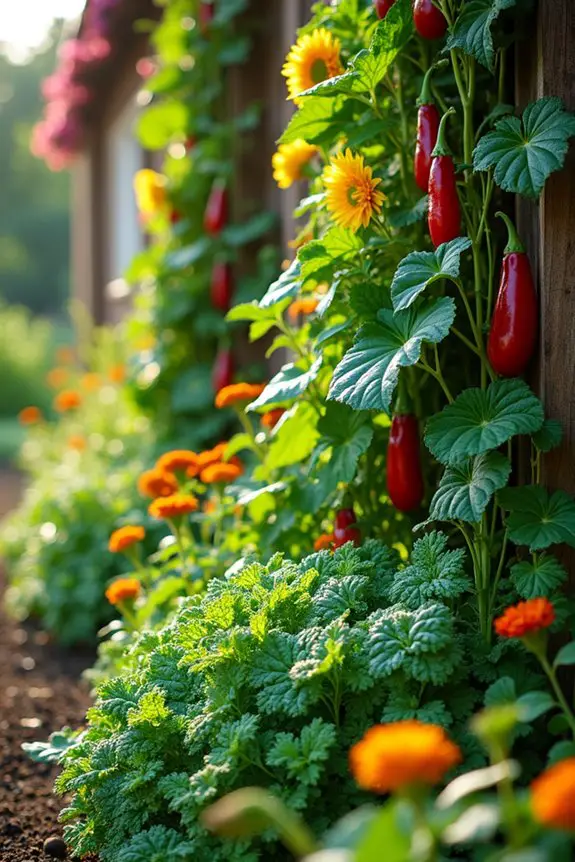
When it comes to creating a vibrant veggie garden, biodiversity is your best friend. Envision this: different plants working together like an all-star team on a mission for maximum growth and flavor. By grouping diverse plants in your vertical garden layout, you not only elevate the aesthetic but also boost functionality. It’s like having a mini ecosystem right in your backyard!
Start by mixing taller plants with shorter ones. Think about pairing your fast-growing beans with leafy greens—those lower guys benefit from some shade while the beans reach for the sky. This layering effect isn’t just smart; it makes for an eye-catching display. Imagine that lush tapestry of greens, reds, and yellows climbing vertically toward the sun. Who wouldn’t be intrigued by a garden that looks as good as it tastes?
As you design, don’t forget about companion planting. Certain combinations, like tomatoes and basil, not only thrive together but also compliment each other’s flavors in the kitchen. I tried this combo last summer, and suddenly, my pasta sauce had a whole new level of deliciousness—who knew my garden could double as culinary magic?
Plus, some plants, like marigolds, can ward off pests, giving your greens a better chance to strut their stuff.
And here’s a little tip: aim for a variety of colors and textures. Mixing leafy greens, vibrant peppers, and robust herbs creates visual drama that draws people into your space. Walking through my kitchen garden feels like stepping into a vibrant painter’s palette—full of color and life.
While you’re at it, consider how these plants will grow together over time, giving you a lush vertical garden that grows fuller and more varied with each season.
6. Hanging Planter Opportunities
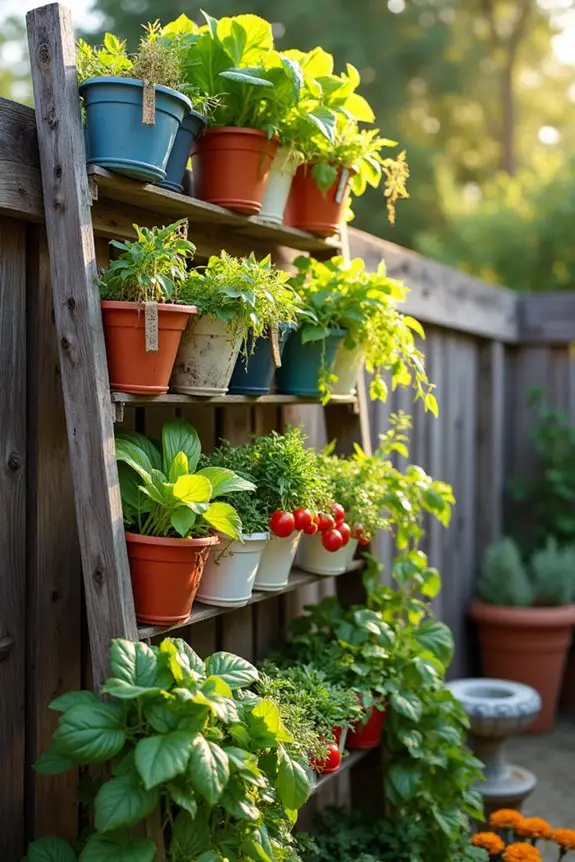
When it comes to maximizing your vertical garden space, hanging planters are the way to go. Not only do they save ground space, but they also add a unique flair that makes your garden pop. Can you imagine colorful veggies cascading down? It’s like a delicious waterfall right in your backyard, and it feels sort of magical, doesn’t it?
Start by scouting for the ideal spot—look for areas that get plenty of sunlight but also consider shade-loving plants if those are your jam. You can use repurposed items like old shoe organizers, wooden pallets, or even hanging baskets that you snagged at a yard sale. Before you know it, you’re creating a charming showpiece that showcases your culinary ambitions.
I once transformed an old wooden ladder into a vertical herb display, and I can’t tell you how many compliments I’ve received. Plus, I didn’t even have to hire an interior designer.
Once your framework is set, think about what to plant. Leafy greens like lettuce and spinach do great in hanging planters. They’re not deep-rooted, so they thrive in smaller spaces. If you want a splash of color, try cherry tomatoes—they’ll dangle and look stunning, and trust me, nothing feels better than plucking a warm, sun-kissed tomato right before you toss it in your salad.
Pro tip: Make sure your planters have good drainage. Nobody wants soggy roots, right? You can easily poke holes in the bottom or choose planters designed for drainage. And don’t forget to rotate your crops every few seasons, giving your plants the best chance at a happy, healthy life.
Lastly, when choosing your hanging setups, consider how they’ll look against your outdoor decor. A beautiful hanging planter can be a focal point or a delightful surprise for your garden guests.
Creating a visually appealing space is part of the joy of gardening, after all. So embrace the charm and let your veggie garden shine—who knew veggies could be so stylish?
7. Edible Flower Integration
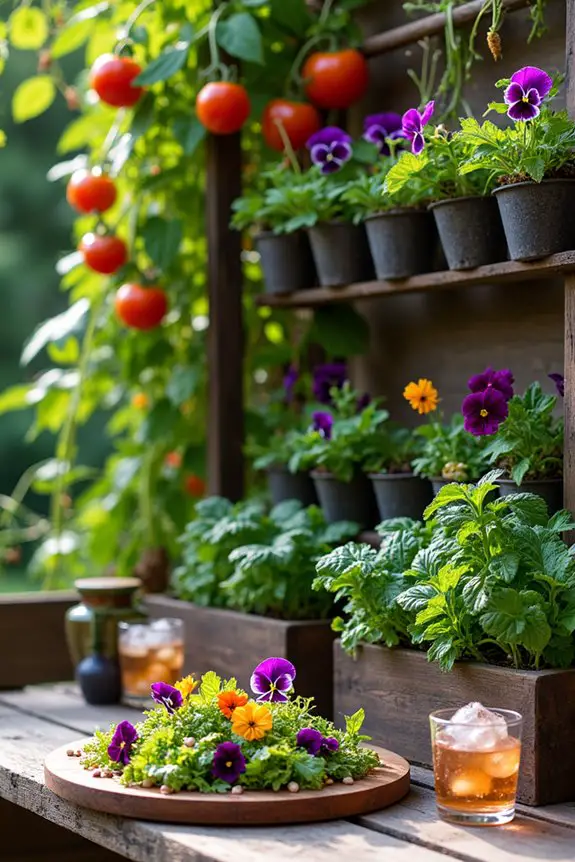
Integrating edible flowers into your vertical veggie garden not only adds a burst of color but also brings a delightful twist to your cooking. Imagine plucking vibrant nasturtiums or sweet pansies right from your garden to throw on top of your salad. Who wouldn’t want to entice their friends and family with dishes that are as beautiful as they’re delicious?
Plus, edible flowers are often packed with nutrients, so it’s like a little health bonus in every bloom.
Start by selecting varieties that grow well in the same conditions as your veggies. Nasturtiums love the sun, just like tomatoes. They thrive in similar soil and can even help deter pests. So, think of them not just as decor but as your garden’s little bodyguards.
Try pairing them in hanging planters alongside leafy greens – the greens will keep the flowers company as they grow together. It’s a friendship made in gardening heaven.
When you plant these flowers, make sure to give them enough room. They won’t take over your garden space, but they do like to spread out a bit. A few well-placed flowers can make your vertical layout feel fuller and richer, without overcrowding your veggies.
Plus, they add variety, which is essential to keep it interesting—who wants a one-note garden?
Remember to harvest those blooms, too. They not only add flair to your meals but can also be frozen in ice cubes for a memorable presentation when you’re entertaining.
There’s something special about serving drinks that look as good as they taste. It’s like you’re a mini botanical mixologist.
Truly, who knew your backyard could turn into such a chic dining experience? The garden is your canvas, and those edible flowers? They’re your stylish paintbrushes.
8. Soil Texture Considerations
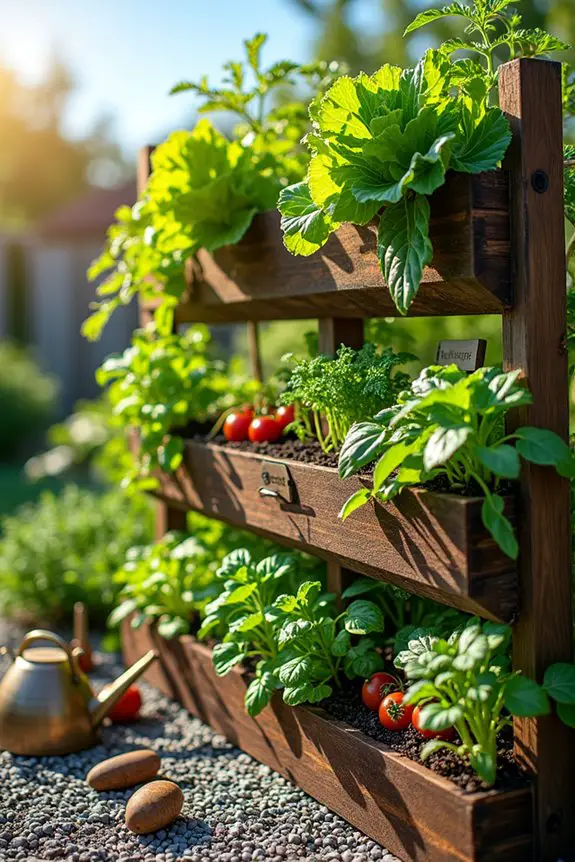
When it comes to vertical veggie gardening, the soil you choose can make all the difference in how your garden thrives. The right soil texture not only affects how well your plants grow but also gives your garden a vibrant and healthy vibe. Think about it: lush greens twining up trellises, dancing in the sunlight, while succulently juicy tomatoes are just a reach away. That’s the dream, right?
So, let’s break it down. You want to aim for soil that’s well-draining yet retains moisture. A perfect mix would be loamy soil—think of it as the Goldilocks of garden soil. Not too sandy, not too clayey. Loamy soil is packed with nutrients and has a lovely crumbly texture that encourages root growth. You can easily DIY your mix by combining equal parts of compost, peat moss, and vermiculite. I mean, who knew mixing things could be so satisfying?
Next, check your soil’s pH levels. Most veggies prefer a slightly acidic to neutral range, around 6.0 to 7.0. A quick and dirty way to check is to grab a pH testing kit from your local garden center. It’s like a little science experiment, minus the lab coats—and hey, science is cool.
Adjust as needed with amendments, but don’t worry; plants have a funny way of forgiving us for our tiny mistakes.
Consider adding organic matter, too. Not only does it improve the texture of your soil, but it also provides a buffet of nutrients. Plus, it helps attract earthworms, which are nature’s little gardeners. Who doesn’t want hard-working allies in the fight against pesky bugs? Just imagine them digging around, doing the good work while you sip lemonade nearby. Sounds like a pretty sweet deal to me.
And don’t forget about the layers in your vertical garden setup. Mix in some gravel at the bottom of your planter boxes to help with drainage, and then layer that rich loamy mix on top.
This way, your veggies have room to breathe, and those roots can explore deep without drowning. It’s like creating a beautifully organized home for your plants—who doesn’t appreciate a little structure in life?
9. Seasonal Color Coordination Strategies
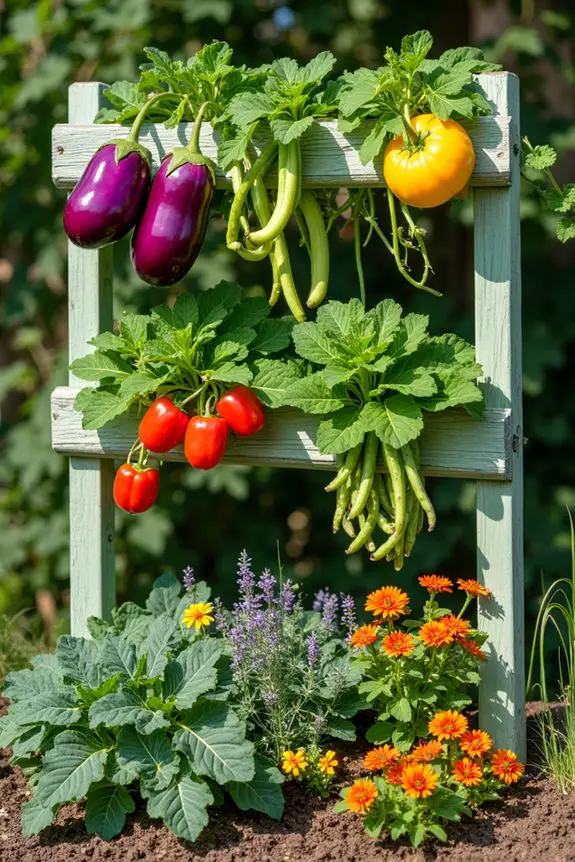
When you think of a vertical veggie garden, it’s easy to focus on the plants, but don’t overlook the power of seasonal color coordination. Mixing hues not only creates a feast for the eyes but also helps you identify ripeness at a glance. Envision this: lush green leaves contrasting against the vibrant reds, yellows, and purples of your veggies. It’s like inviting Mother Nature to paint your garden with a palette that evolves through the seasons, making each harvest feel like an event.
Start by choosing a base color for your vertical garden. If you lean towards greens, which is a classic look, think about pairing them with colorful fruits and veggies like red bell peppers or golden squash. This combo allows those greens to pop, resulting in a striking backdrop.
Alternatively, if you’re feeling adventurous, embrace the rainbow. Plant purple eggplants beside bright orange marigolds, alongside green beans climbing their trellis. Talk about a show-stopper.
Don’t forget the impact of flowers, too. They can add cheerful splashes of color to your veggie patch. Edible flowers like nasturtiums bring in shades of orange and yellow, while also attracting pollinators to help your garden thrive. Think about how lovely it would be to snack on a salad that screams summer, garnished with vibrant, freshly-picked flowers. Not too shabby for a night out at home.
Another tip? Keep an eye on the seasons. Spring is all about pastels—think soft greens, light yellows, and lovely lavenders. As summer rolls around, bold colors dominate. You can switch things up with autumn hues as the days get shorter, showcasing rich reds, deep greens, and golden tones. This way, your vertical garden will visually evolve, keeping your gardening game fresh and exciting.
In the end, color coordination should be a fun, creative outlet. Don’t stress over perfection. Just think of it as a way to strut your gardening personality—maybe a little chaos, a splash of refinement, or a whole lot of whimsy.
10. Garden Pathway Inspirations
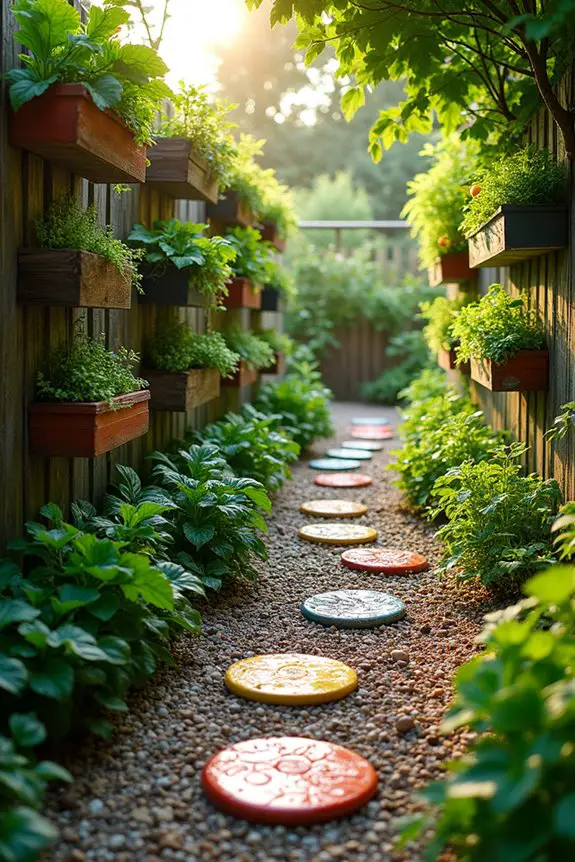
Creating a stunning garden pathway for your vertical veggie garden isn’t just about function—it’s about inviting wonder into your green space. Picture walking through a vibrant array of veggies, all while your feet find a path that adds charm and practicality. Plus, let’s face it: pathways keep you from veering off and accidentally tripping over a trellis or a rogue tomato plant. Not that I’ve ever done that…often.
First, think about the materials you want to use for your pathways. Gravel, wood chips, or pavers—they can set the mood. Gravel gives a rustic feel, while wooden paths can introduce a warm, natural vibe when paired with lush green veggies. If you’re feeling fancy, why not lay down some colorful pavers? It’s like giving your garden a little personality upgrade. And yes, your tomatoes will totally notice.
Now, let’s get practical. Start by mapping out the layout of your vertical garden. For instance, consider creating a zigzag pathway between your veggie installations, allowing for easy maintenance and accessibility. There’s nothing more satisfying than strolling through your garden and tending to your leafy friends without doing the ‘gardener shuffle’ around obstacles. Besides, a straight pathway could be too basic, right? We’re all about a little adventurous flair here.
Next, you’ll want to make sure your pathway is wide enough to comfortably navigate—all while brimming with exuberant herbs and veggies on either side. A good rule of thumb? Aim for about two feet wide. This way, there’s room for you, a friend, and maybe even that neighbor who insists on borrowing your gardening tools. (You know, the one who returns them covered in mystery dirt.)
Lastly, infuse your pathway with a sprinkle of personality. Think quirky signs leading the way to your veggies or decorative pebbles lining the edges. You could even add a few stepping stones with whimsical designs. Imagine the smiles as you stomp your way to the cucumber patch.
It’s all about creating a journey that’s enjoyable every time you step into your garden. So, whether you’re simply grabbing some lettuce for dinner or inviting friends for a garden gathering, your pathway will set the right tone, adding both charm and ease to your vertical paradise.
Pest Control Techniques
Pests can feel like the uninvited guests at your veggie garden party, can’t they? To keep your garden thriving, you need some crafty pest control techniques.
First off, consider companion planting. Pair up plants like marigolds with your veggies; those little flowers can repel unwanted bugs. You could also whip up a DIY insecticidal soap—just mix a touch of dish soap with water and spray it on those pesky critters.
If you’re feeling adventurous, why not introduce natural predators? Ladybugs are like the bouncers of your garden, keeping aphids at bay.
And trust me, using row covers can be a game-changer, giving your plants a protective blanket. With these veggie garden ideas, you’ll have a thriving garden in no time!

